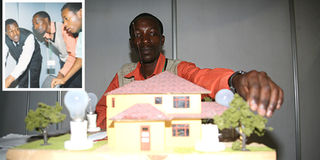Your face is all you’ll need at an ATM

Exhibitor Simon Mwaura shows how a mobile phone automated house security system works, while inset, Brian Kiprono (left) a student at the Jomo Kenyatta University of Agriculture and Technology demonstrates how an intelligent ATM works during the national scientific conference at KICC in Nairobi. Photos/HZERON NJOROGE
What you need to know:
- Innovation comes with a camera that sends details of facial features to data base
You may soon withdraw money from an Automated Teller Machines without using your credit or debit card, thanks to a face recognition technology in the making.
Known as the Basic Intelligent Automated Teller Machine, if the new device is incorporated in the current ATMs, all one will require to get money is to stand in front of the machines.
It is the brainchild of Dr Waweru Mwangi, the director of the Institute of Computer Science and Information Technology at Jomo Kenyatta University, and is on display at the national scientific conference in Nairobi.
Feel uncomfortable
The smart ATM removes the need to carry cards every time one wishes to access the bank account. The idea behind the machine’s development is to make banking friendly.
“We realised that many people feel uncomfortable with the card, which in some cases is retained by the machine,” Dr Mwangi says.
Its use could also reduce the now common incidents where carjackers force their victims to empty their accounts at gunpoint, often taking the card and the personal identification number (PIN).
The Intelligent ATM comes equipped with a camera that recognises the customer’s face and sends details of the facial dimensions to a database for verification.
The camera uses the system of biometrics to recognise the account holder — those used in computer science are the distance between the eyes and the proportion of the nose to the mouth and the location of the cheekbones.
Once the image is found to be authentic, the customer is then prompted to enter their PIN or asked a personal question such as “What’s your pet’s name?”
The correct PIN or answer would then allow the person to use the ATM in the normal way. Your twin brother or sister would pass the face test but fail at the PIN or question stage.
It also impossible to use a life-size photograph of the account holder as the machine uses three dimensions, length, width and depth, to recognise the image.
Dr Mwangi said the only requirement would be for the software to be working properly and then it would be linked to the current system of machines in use.
Face recognition technology is used to control access to buildings, but Dr Mwangi said it has never been used in ATMs anywhere in the world.
Dr Mwangi said at the current rate of progress, a prototype would be ready for testing in six months and then the idea would be sold to banks and implemented.
It is one of the projects being developed by the National Council for Science and Technology and Jomo Kenyatta University of Agriculture and Technology.
However, face recognition technology has struggled to perform under certain conditions in other countries where the technology has been tested, some researchers say.
Mr Ralph Gross, an American researcher at the Carnegie Mellon Robotics Institute, says where face recognition does not work well include poor lighting, sunglasses, long hair, or other objects partially covering the face, and low resolution images.
However, the Kenyan innovators are optimistic that they will beat the setback upon further improvement of the technology.
And at the same exhibition, two student innovators have finally presented the bicycle-powered smart mobile phone chargers in the market.
This is a year after Pascal Katana, 24, and Jeremiah Murimi 25, featured their innovation at the national scientific conference. The simple device is expected to change lives in rural areas as well as boost the boda boda industry.
The tool is known as a smart charger and is powered by a bicycle and costs Sh350.




